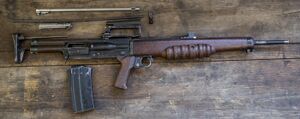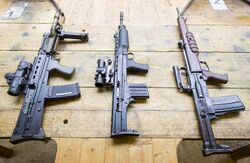Engineering:EM-2 rifle
| No9 bullpup rifle | |
|---|---|
 The EM-2 as Rifle No. 9 | |
| Type | Bullpup assault rifle |
| Place of origin | United Kingdom |
| Service history | |
| In service | 1951 |
| Used by | See Users |
| Production history | |
| Designer | Stefan Kenneth Janson |
| Designed | 1948–1950 |
| Manufacturer | RSAF Enfield Canadian Arsenals Limited Chambons Birmingham Small Arms Company[1] |
| No. built | 59[2] |
| Variants | 6.25×43mm, 7×49mm, 7×51mm, 7.62×51mm NATO, .30-06 Springfield, Carbine, HBAR, Winter trigger variant[1] |
| Specifications | |
| Mass | 3.49 kg (7.7 lb) |
| Length | 889 mm (35.0 in) |
| Barrel length | 623 mm (24.5 in) |
| Cartridge | .280 British |
| Action | Gas-operated, Flapper Locked |
| Rate of fire | 450–600 round/min (7.5 to 10 /s) |
| Muzzle velocity | 771m/s (2,545 ft/s) |
| Effective firing range | 700 m (770 yd) |
| Feed system | 20-round detachable box magazine |
| Sights | Optical |
The EM-2, also known as Rifle No.9 Mk1 or Janson rifle, was an experimental United Kingdom assault rifle. It was briefly adopted by British forces in 1951, but the decision was overturned very shortly thereafter by Winston Churchill's incoming government in an effort to secure NATO standardisation of small arms and ammunition. An innovative weapon with the compact bullpup layout and an optical sight, it used one of the early intermediate cartridges (a concept introduced by the Germans with the 7.92×33mm Kurz) as a result of combat experience and German advances in weapons design during World War II.
It used the experimental, intermediate powered, but highly efficient .280 British round, which was designed to replace the venerable .303 round and Lee–Enfield rifle variants which had served since before the turn of the 20th century. The United States claimed the .280 British round was too weak for use in rifles and machine guns, and instead favored the much more powerful 7.62×51mm NATO round. As the EM-2 could not be easily adapted to the longer and more powerful round, it faded from use. However, the bullpup layout for a British service rifle was finally adopted some years later in form of the SA80 assault rifle, the EM-2's spiritual successor, which remains in service today.
Background
In the immediate post–World War II era, the British Army, like many other forces, started research into their own assault rifle. The British Army had originally planned to replace their .303 inch rimmed cartridge before World War I, but were forced to keep it for another 30 years due to time and financial constraints.
With these constraints removed, they developed a new .280 inches (7.1 mm) intermediate-power round, and set about developing a new rifle to fire it, as well as considering a machine gun using the same round, the Taden gun.
At the same time Fabrique Nationale expressed considerable interest in the round, and started development of their own rifles based upon it. The Canadian Army also expressed interest in the new round, both to maintain commonality with the British and to modernize their forces.
The Royal Small Arms Factory (RSAF) at Enfield started working on four designs, of which two generally similar designs known as the EM-1 "Cobra" (designed by Stanley Thorpe) and the EM-2 "Mamba" (the "EM" standing for Experimental Model)[3] came to the fore. The EM-3 (designed by Major Eric Hall) and EM-4 (designed by Dennis Burney) did not proceed beyond the drawing board.[3] The nomenclature was made official on January 6, 1948.[4] Both were unofficially named after the lead designers in each team and were known as the Thorpe rifle and the Janson rifle respectively (Stefan Kenneth Janson was an assumed name of the Polish firearm designer Captain Kazimierz Januszewski).
Both were bullpup-style weapons; the magazine and chamber are placed behind the trigger and pistol grip, leading to a shorter overall length (by about 20%) and a better ratio between barrel length and weapon length (the overall length of the EM-2 is 9.5 inches less than the U.S. M14, but its barrel is 2.5 inches longer).[3]
Both EM-1 and EM-2 used 20-round magazines with "charger" reloads, included simple conical optical sights for fast aiming, had a carrying handle built into the top, could fire semi-automatic or fully automatic and the .280 round was accurate to about 800 yards (730 metres). The two designs were superficially similar but were internally very different in design and construction,[3] with no parts in common other than sights. The EM-1 used steel plate pressings for simpler manufacture, and was slightly heavier. A fifth design was commissioned from the BSA company, who built prototypes of a more conventional rifle using the same 7mm round, the BSA 28P.[3] The EM-2 was eventually selected as the better design, and was adopted as the British Army's new rifle on April 25, 1951 as the Rifle, Automatic, Calibre .280, Number 9,[5] the designation by which it had been known in the War Office since the American weapons tests of 1950.[6]
In common with other 20th century British designs such as the P14 and SA80, the EM-2 was designed to achieve a high degree of accuracy due to the tradition of British Army emphasis on marksmanship.
Though not adopted, the British toy soldier company Herald Miniatures, later acquired by Britains, designed its modern British Infantry figures using the weapon.
NATO standardisation
With the creation of NATO in 1949, there was a clear preference that NATO forces would have commonality of weapons and ammunition, so weapons designs had to meet with the approval of more than one government, and it was hoped, would be adopted by the organisation as a whole. It was at this point that the US put forth its own designs for NATO standardisation, using the 7.62×51mm NATO round in their prototype T25 and T44 rifles. Matters came to a head in 1951 in a shoot-off conducted at the Aberdeen Proving Grounds, with the US claiming the British round was underpowered, and the British claiming the US round was too powerful to be used in a rifle in full-automatic mode. At the same trials the Belgian .280 FN FAL was also tested.
A series of lengthy debates followed, which were finally settled in an unlikely fashion when Canada stated they would use the British .280 round, but only if the US did as well. It was clear this would never happen. Winston Churchill felt a NATO standard was more important than any qualities of the weapon itself and overturned the decision by the previous Labour Minister of Defence, Manny Shinwell, who had already announced an intention to move to the .280 and the EM-2. During this time, prototype EM-2s were built in several different calibres: Chambons built two for the 7×49mm "Second Optimum" cartridge and another two for the 7.62×51mm NATO.[1] One of the Chambon prototypes was even rebuilt for the US .30-06 cartridge.[1] RSAF-Enfield and BSA built 15 and 10 prototypes for the 7.62×51mm, respectively.[7] Canadian Arsenals Limited also built 10 rifles for the 7×51mm "Compromise" cartridge.[8]
It was clear the EM-2 could not be easily adapted to the powerful 7.62×51mm NATO round, so the only realistic alternative was to adopt a licensed version of the FN FAL from Fabrique Nationale. Created by Dieudonné Saive, the FAL was itself a re-designed version of FN's own design for an intermediate cartridge rifle using the .280 round (the first prototypes had used the 7.92×33mm Kurz German round from the StG44). However, the FAL was more easily adaptable to handle the more powerful, longer round.
It grew in weight and length as a consequence. Churchill had hoped that with the British Commonwealth and other NATO countries adopting the FN FAL the US Army would do so as well, however the US adopted the T44 (an updated version of the M1 Garand) as the M14, which had won US trials against a more radical experimental rifle, the T25.
In time, the British position on intermediate cartridges was vindicated, the 7.62×51mm proving to be too powerful to be controllable in rifles using automatic mode, smaller cartridges being deemed necessary for that application. Due to combat experience in Vietnam in the mid-1960s, the US adopted the AR-15 as the M16. Chambered for the 5.56×45mm NATO intermediate cartridge, the M16 replaced the M14 which had been adopted little more than a decade earlier.
Some years afterwards, NATO also agreed to move to a smaller round more suitable for full-automatic fire and lighter weapons, ultimately adopting the 5.56×45mm. Prior to committing to the 5.56mm, the British Army conducted additional intermediate cartridge research.
Around 1970, a pair of the original .280 EM-2 were re-barrelled for an experimental 6.25×43mm cartridge.[9] However, the revival of the EM-2 was short-lived as the 6.25mm was dropped for an even smaller 4.85mm cartridge in a completely new rifle, the L64/65 which evolved into the 5.56mm SA80 currently used by the British Army. In spite of having a similar appearance due to its bullpup layout the SA80 is mechanically unrelated to the EM-2; rather it is essentially a bullpup adaptation of the AR-18/SAR-87. However, the concept of an Infantry Personal Weapon which led to the design of the EM-2[3] was reflected in the SA80 system.
Users
See also
- KAL1 General Purpose Infantry Rifle, Similar Australian concept intended for Jungle Warfare conditions.
- SLEM-1
- L64/65
- Model 45A
- Sieg rifle
- List of bullpup firearms
- List of assault rifles
Notes
References
- Dugelby, Thomas B. (1980). EM-2: Concept and Design. Toronto: Collector Grade Publications. ISBN 978-0-88935-002-1.
- Hogg, Ian V.; Weeks, John (1977). Military Small Arms of the 20th Century. Arms & Armour Press / Hippocrene. ISBN 0-85368-301-8.
- Hobart, Major F. W. A. (1972). Guns Review Vol. 12 Number 3 - The British 7mm (.280 in) Rifles. London: Ravenhill Publishing Company Limited.
- Williams, Anthony G (25 September 2010), The .256 Inch British: A Lost Opportunity, http://www.quarryhs.co.uk/256brit.htm
- Williams, Anthony G (November 2014), Assault Rifles And Their Ammunition: History And Prospects, http://www.quarryhs.co.uk/Assault.htm
External links
- Enfield EM2 at securityarms.com
- Enfield EM2 at world.guns.ru
- EM2 specifications
- British Pathé newsreel of the EM-2
- Canadian Arsenal Limited variant with winter trigger
- "New British Rifle Outfires U.S. Garand" , October 1951, Popular Science of the first general public articles on the EM-2 in the US.
- Antill, P. (29 July 2009), The EM-2 (Rifle No. 9, Mk 1): Britain's Original Bullpup Rifle
- video of 7.62 variant: shooting and disassembly




